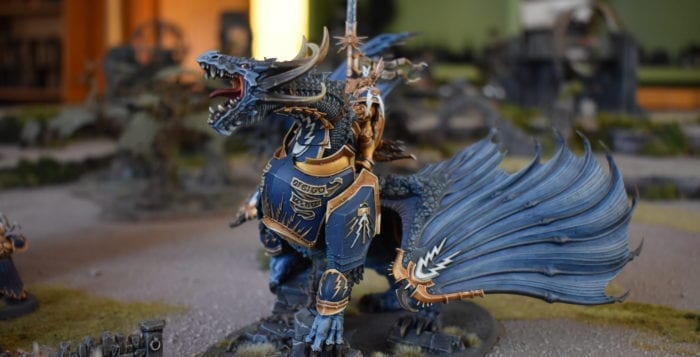By Kyle Barr
There — on the battlefield — the Stormcast Eternals, bronze warriors crafted from lightning and forged by a god, stand with warhammers clenched in armored fists. Their boots shake the ground as they march forward, and their leader, a Lord Celestant, wields the power of celestial energies and is mounted on a Stardrake, a hulking, dragonlike being of taught muscles and scales harder than steel.
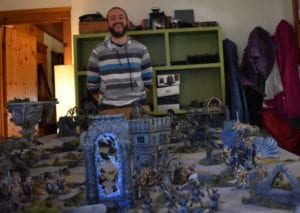
Across the field the sound of malevolent drums beat, making the sky pulse like a frantic heart. A dark and infernal energy swirls above the heads of the opposing army, the frayed host known as the Blades of Khorne. They stalk forward with axe in hand and slaughter on their minds. Dressed in obscene symbols and blood red armor, they pay tribute to a god of chaos that grants his disciples power as long as they only kill, maim and burn. The two armies clash up and down the field, as order and chaos struggle in an unremitting conflict.
Then Huntington resident Ian Craig takes a step back. That field of battle is just a table made from insulation foam and sand. The soldiers are just pieces of plastic less than 1/32 the scale of a human being. It’s all a game called Warhammer: Age of Sigmar, which uses dice and tape measurements to decide the outcome of a battle instead of martial prowess.
Craig is a professional miniature artist, and all those figures and terrain below him took hours upon hours of painstaking work to build and then paint, but it is a love for a craft he perfected since he was a kid, and a love of a game that has helped him find lifelong friends.
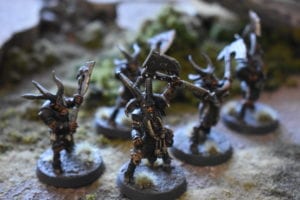
“That is what I enjoy most –— when you have this all together, the game transcends a board game, it becomes its own experience,” said Craig during a recent tour of his studio. “It’s really quite a different experience with that kind of beautiful terrain with those kinds of well-painted armies. One of the greatest things about this is we’ve lost, in general, so much of the connectivity between people.”
But it is perspective that matters. In terms of miniature war-gaming, looking at things at such a small scale, perspective is everything. The table and miniatures are so detailed because in it, while playing, everything becomes immersive. The game becomes more than a game; it becomes a narrative that unfolds with each decision and roll of the dice. “My favorite thing is sharing the hobby, and I think why I’m doing this primarily is because most people don’t get the full experience,” Craig explained.
Now the professional artist wants to turn a portion of his property into a gaming club, one that can facilitate all kinds of gamers, from old hands to young novices. Craig, who recently opened a painting studio called Old Well Miniature Studio in his home, said the game brings people together, and he envisions a space that has the beauty, narrative and immersion that makes the game come alive. “I want people to walk in, start playing and feel like they’re right in those books,” he stressed. “The place will be built to be an immersive experience.”
Until recently, Craig was a teacher at the nonprofit Love of Learning Montessori private school in Centerport, where his wife Lille has recently been named director. Ongoing seizures have forced him to leave teaching, and he misses the kids whom he got to know from first grade all the way to fifth grade. But this hobby-turned-profession has long been Craig’s way to look at things differently.
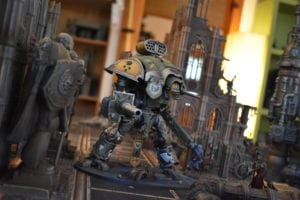
The setting of the game borrows elements from history, but plainly the entire thing is ridiculous. Warhammer’s tone in particular is so dark, despairing, yet ludicrous all at once. The game has been a way for the Huntington resident to enjoy something that does not take itself so seriously.
“It was my escape,” Craig said. “You can mirror your own life situations with that theme, then laugh at it and turn it into something humorous.”
It is a mindset that allows the artist to turn out project after project. Craig spent several years in the early 2000s as a miniature artist for Games Workshop, the company that makes Warhammer: Age of Sigmar and its sister product Warhammer 40,000.
“As an adult I got good at it,” Craig said. “I would go so far as to say it is not an obsession. It’s becoming a profession.” He is still working on his designs and is waiting for the necessary space to become available, but in the future, he already has plans for tournaments, community painting sessions and even after-school programs for kids.
Craig sees many advantages to learning a game like this, especially as a teacher. “You’re teaching fine motor skills, patience, math, reading comprehension to read these rules, interacting, being able to discuss something and come to a consensus, being able to communicate with different people, tactics and imagination, are all engaged on so many levels,” he said.
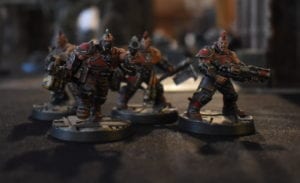
By next year Craig envisions the 1,500 square feet of space will make you feel like you’re stepping into another reality, straight out of a Tolkien-esque fantasy story. The space will include a downstairs area for war-games with multiple tables, and the upstairs for a role-playing game library, a separate rentable room for role-playing sessions and the ability to videotape and live stream games so they could post them online.
Even with all that work, Craig doesn’t plan to make much money for this venture, and only needs enough funds to keep the lights on because when all the miniatures are out on the table, with armor-clad warriors stomping through the brush, yelling battle cries and swinging axes the size of an average-sized human being, it reminds Craig what has made the whole thing such a lasting passion.
“There’s so much to this hobby that’s so good,” Craig said. “We have a community that needs something like this.”

